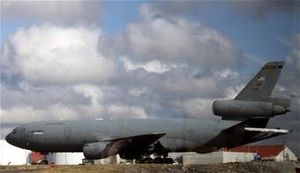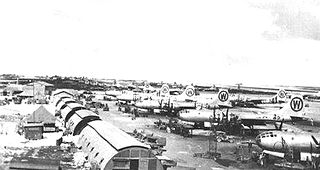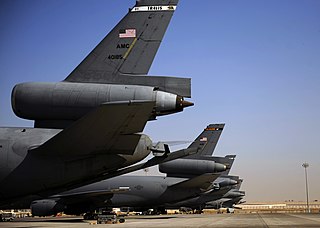32d Air Refueling Squadron  | |
|---|---|
 | |
| Active | 1917–1919; 1932–1945; 1946–1964; 1964–1979; 1981-present |
| Country | |
| Branch | |
| Role | air refueling |
| Part of | Air Mobility Command |
| Garrison/HQ | Joint Base McGuire-Dix-Lakehurst |
| Motto(s) | Linking the Continents (1966-present) [1] |
| Engagements |
|
| Decorations |
|
| Insignia | |
| 32d Air Refueling Squadron emblem (approved 27 September 1995) [2] |  |
| 32d Air Refueling Squadron emblem (approved 23 August 1982) [1] |  |
| 32d Bombardment Squadron emblem (approved 21 November 1936) [3] |  |
The 32d Air Refueling Squadron is part of the 305th Air Mobility Wing at Joint Base McGuire-Dix-Lakehurst, New Jersey. It operates the KC-10 Extender aircraft conducting air refueling missions.

The 305th Air Mobility Wing is a United States Air Force strategic airlift and air refueling wing under the operational control of the Air Mobility Command. It generates, mobilizes and deploys C-17 Globemaster III and KC-10 Extender aircraft. The 305th AMW is a tenant unit at Joint Base McGuire-Dix-Lakehurst in central New Jersey. It also controls one of the Air Force's busiest aerial ports, and the air operations at both McGuire Air Force Base and Naval Support Activity Lakehurst.

McGuire AFB/McGuire, the common name of the McGuire unit of Joint Base McGuire-Dix-Lakehurst, is a United States Air Force base located in Burlington County, New Jersey, United States, approximately 16.1 miles (25.9 km) south-southeast of Trenton. McGuire is under the jurisdiction of the Air Mobility Command. It was consolidated with two adjoining US Army and Navy facilities to become part of Joint Base McGuire-Dix-Lakehurst on 1 October 2009. The McGuire Air Force Base census-designated place (CDP) is located in portions of both New Hanover Township and North Hanover Township.
Contents
- History
- World War I
- Inter-war years
- World War II
- Cold War
- Modern era
- Lineage
- Assignments
- Stations
- Aircraft
- See also
- References
- Notes
- Bibliography
- External links
The squadron is one of the oldest in the United States Air Force, its origins dating to 19 May 1917, being organized at Kelly Field, Texas. The squadron deployed to England as part of the American Expeditionary Force during World War I. During World War II, the squadron saw combat service as a B-17 Flying Fortress unit, assigned to the Fifteenth Air Force in Italy. During the early years of the Cold War, it was an RB-47 Stratojet Strategic Reconnaissance Squadron as part of Strategic Air Command (SAC)

World War I, also known as the First World War or the Great War, was a global war originating in Europe that lasted from 28 July 1914 to 11 November 1918. Contemporaneously described as "the war to end all wars", it led to the mobilisation of more than 70 million military personnel, including 60 million Europeans, making it one of the largest wars in history. It is also one of the deadliest conflicts in history, with an estimated nine million combatants and seven million civilian deaths as a direct result of the war, while resulting genocides and the 1918 influenza pandemic caused another 50 to 100 million deaths worldwide.

World War II, also known as the Second World War, was a global war that lasted from 1939 to 1945. The vast majority of the world's countries—including all the great powers—eventually formed two opposing military alliances: the Allies and the Axis. A state of total war emerged, directly involving more than 100 million people from over 30 countries. The major participants threw their entire economic, industrial, and scientific capabilities behind the war effort, blurring the distinction between civilian and military resources. World War II was the deadliest conflict in human history, marked by 50 to 85 million fatalities, most of whom were civilians in the Soviet Union and China. It included massacres, the genocide of the Holocaust, strategic bombing, premeditated death from starvation and disease, and the only use of nuclear weapons in war.

The Cold War was a period of geopolitical tension between the Soviet Union with its satellite states, and the United States with its allies after World War II. A common historiography of the conflict begins with 1946, the year U.S. diplomat George F. Kennan's "Long Telegram" from Moscow cemented a U.S. foreign policy of containment of Soviet expansionism threatening strategically vital regions, and ending between the Revolutions of 1989 and the 1991 collapse of the USSR, which ended communism in Eastern Europe. The term "cold" is used because there was no large-scale fighting directly between the two sides, but they each supported major regional conflicts known as proxy wars.





























